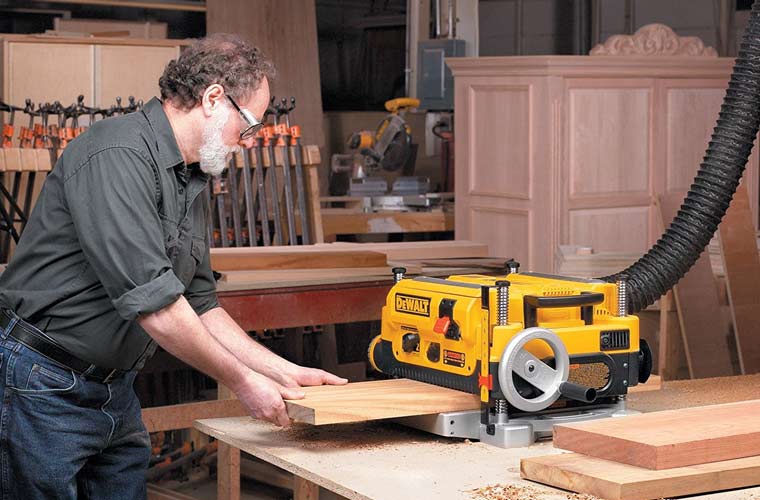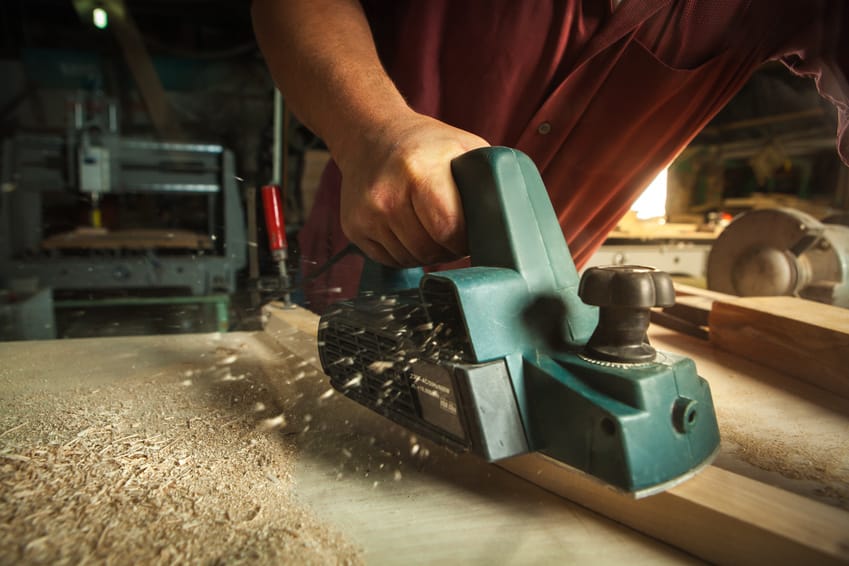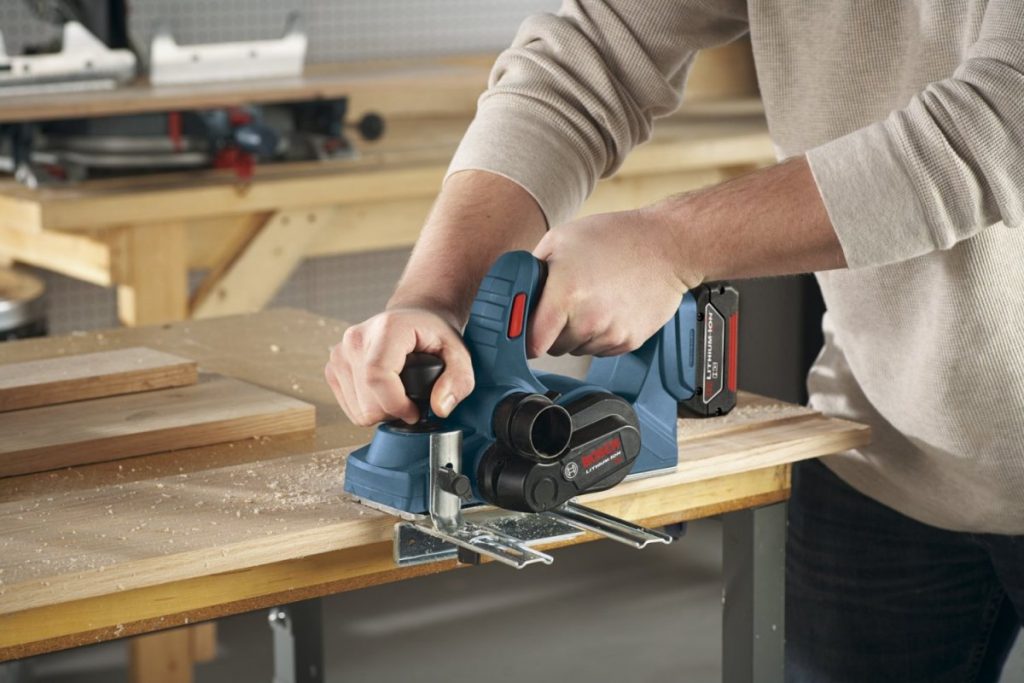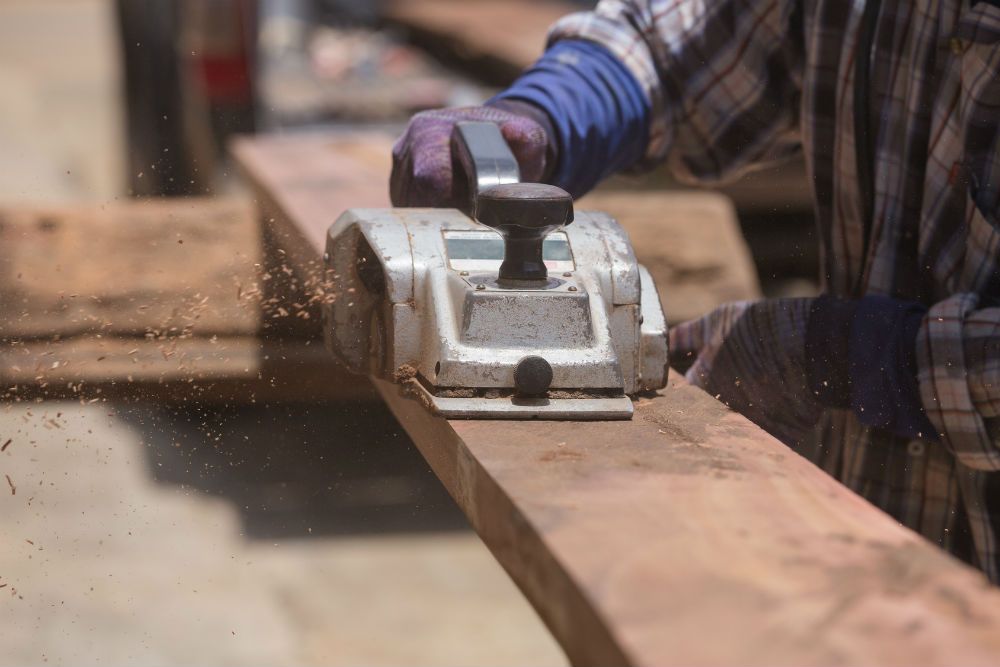Just as there are dozens of types of electric saws used to achieve a range of cuts in all types of wood, there are also dozens of tools used to shape, smooth, straighten and shave off the wood before it moves on to the finishing process. One such tool is a hand plane. This is a basic piece of kit that should be in the toolbox of every carpenter, handyman or woodworker. Planes are designed to remove thin slices of wood one stroke at a time. They shave off millimetres off boards, planks or any piece of wood you’re working on. Like all woodworking tasks, this can become tiring pretty soon. To help out, there are a range of electric planers, that do the same job, just aided with electricity and blades that spin thousands of times a minute. You’ll not only get the job done faster, but can enjoy the fruits of that hard work without breaking a sweat.
Types of Electric Planers
There are two types of electric planers – handheld and benchtop planers. Handheld planers are by far the ones that get the most use. You’ll see them at construction sites, workshops, and general repairs around the house. They’re a more cost-friendly option than larger benchtop planers which are more suitable for shaping and smoothing wood planks and boards in large-scale projects.

Electric Hand Planers – The Basics
An electric handheld planer works on the same principle as an ordinary wood planer. But instead of having a single iron blade, set at an angle of 45 degrees, an electric planer has a pair of (carbide) blades that rotate around a cutter head. Speeds can reach up to 20000 rpm, depending on the output and type of motor. The blades are at the centre of the planer. At the front there is an adjustable plate, that can be moved up or down by rotating a knob located at the top. This sets the depth at which the blade eats into the wood, and the difference between the front adjustable and back fixed plate. To avoid damage to the blades and the workpiece, the tool sits on a backfoot located in the backplate. The picture is completed with a handle that also houses the power and safety switches.

Using an Electric Planer
If you’ve mastered using basic woodworking tools, then a planer won’t need much time to get right. Before working on any piece of wood, you need to ensure that it is firmly in place, either set on a benchtop vice or secured by other means. It is good to start with a moderate cutting depth to remove thinner slices before going deeper. Get into a comfortable position and place the front shoe on the workpiece, without the blade touching the wood. Balance the tool. This is to avoid unwanted cuts and gouges at the ends. Apply pressure to the front, while firmly gripping the front handle. Press the power button. To achieve even cuts, allow the motor to get to operating speeds, and slowly cut along the wood grain. As you near the end, apply more pressure to the back of the planer, while slightly easing the front upward. Again, this is to prevent from eating into the edges.
To remove a specified amount of wood on any type of board or plank, a planer fence fits in holes in the front. This will let you adjust the width of the cut. In addition, the central groove in the front shoe can be aligned to corners, and allows you to get chamfer cuts in the angles you want.

Why You Need an Electric Planer
Planers are versatile tools used for various tasks when working on wood. They are a fast way in removing splintered wood from boards, smoothing and shaving uneven wood surfaces, levelling timber floor joists, flattening boards, getting chamfered cuts, adjusting door and window frames, cleaning out grooves, making rabbet joints and cuts and more. They are tools that get the job done quickly and precisely.

What to Look for in Electric Planers
Most tasks can be done by inexpensive handheld electric planers. There is some variation here, besides branding. Here’s what to look for:
- Blade Width and Cutting Depth – Blade widths and the depth that they can cut into the wood vary. Blades with an 82mm wide cutting surface, and ones that can be adjusted to a maximum of 2.5 mm cutting depth are found on mid-level planers. These will be good enough to handle the majority of jobs. Heavy-duty planers with wider blades that cut deeper will make work faster, but they do come at a cost.
- Blade Materials – Avoid high-speed steel blades as these will wear out quickly. Instead, go for double-sided tungsten carbide blades.
- Motors and Speed Settings – Power output is different among planers. 600 W is a starting point, but the more the merrier. Underpowered units can quickly heat up, meaning longer times to get the job done. Also, look for planers that spin blades at 15000 rpm or more.
- Corded or Cordless – Corded planers are still the norm, though they do limit mobility. If you’re going the corded route, get a planer with at least a 2-metre cord. Cordless planers will be slightly dearer. Go for brushless motors in cordless units to get comparable power, speed and runtimes as corded planers.
- Features and Accessories – Guide fences allow for versatility in achieving differently sized precision cuts. Also, look for decent dust extraction, with bags that collect dust on one or both sides. Magnets do a good job in locating hidden nails in the wood, so there’s no damage to the blades.


















